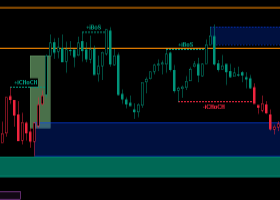Experts believe that Bitcoin is heading for a period of prosperity. The first cryptocurrency is paving its way upward thanks to an influx of capital. This source of growth for BTC remains strong, although the situation could change at any moment.
Currently, Bitcoin is fluctuating around $97,000, which is an expansion of the range it traded in from $98,600 to $95,000 last week. According to current data and technical indicators, Bitcoin remains in a strong position, although key levels of resistance and support will determine its next move. On Monday, February 17, BTC is trading at $96,230, trying to rise higher.
The price fluctuation range for BTC suggests potential profit-taking by market participants. The price distribution has shown strong support near $90,000, while resistance around $100,000 may determine the next step for BTC.
To date, the extreme price deviation ranges of MVRV (Market Value to Realized Value ratio) have shown strong volatility in the crypto, which has then decreased.
Although BTC briefly touched the upper deviation bands, overcoming this area would push it to new highs. On this path, Bitcoin is expected to face a short-term correction. Additionally, the current strong support level for BTC is near $93,000.
The UTXO (Unspent Transaction Output) realized price distribution chart (URPD) has shown that a significant volume of BTC transactions took place in the range of $90,000 to $101,000. The concentration of transactions in these price zones suggests strong support and reduces the likelihood of the asset falling below $90,000 without substantial selling pressure. However, Bitcoin will need a strong bullish impulse to break higher.
From a technical standpoint, BTC's dynamics remain stable, trading slightly below its 50-day moving average of $98,801. The 200-day moving average for Bitcoin is at $80,021, providing long-term support. BTC's technical indicators signal cautious optimism regarding its near-term dynamics.
Analysts believe the first cryptocurrency may make another attempt to rise if buyers regain control of the situation. Experts are noting the potential for further BTC growth, given its current key support and resistance levels. A breakthrough above $101,000 would open the path to new highs, while an inability to stay above the $90,000 mark could trigger short-term bearish sentiment.
If Bitcoin breaks the resistance level of $99,470, it will trigger a new buying impulse, pushing its price back above the round $100,000 level. However, in the case of a prolonged correction and increasing selling pressure, BTC could fall below the support level of $94,660.
According to analysts, Bitcoin is entering a crucial phase. Its further dynamics will be determined by current support and resistance levels, as well as financial inflows from market participants.
According to the online analytical platform IntoTheBlock, the net inflow of BTC to crypto exchanges over the past week amounted to $1.4 billion. However, this flow of funds could dry up if the global economic and political situation worsens. Currently, among Bitcoin holders, there is a sense of indecision and tension, driven by geopolitical uncertainty.
The main factor behind the recent sharp inflow of funds into Bitcoin exchanges was the outflow of funds from spot Bitcoin ETFs. Previously, US-based spot Bitcoin ETFs became a powerful driver for BTC growth at the end of 2024 and the beginning of 2025. However, last week brought disappointments for crypto funds.
According to data from SosoValue, the net outflow of funds from US spot Bitcoin ETFs over the past week amounted to $651.83 million. This is the largest weekly outflow recorded from spot Bitcoin ETFs since the first week of September 2024. Experts believe this trend is due to some institutional investors selling Bitcoin either to take profits or in response to ongoing uncertainty following the sharp drop in BTC prices in early February.
Nevertheless, the first cryptocurrency remains focused on further growth. Among Bitcoin holders, there is an optimistic sentiment. The current situation supports the flagship asset, which, under any circumstances, is trying to stay afloat.


